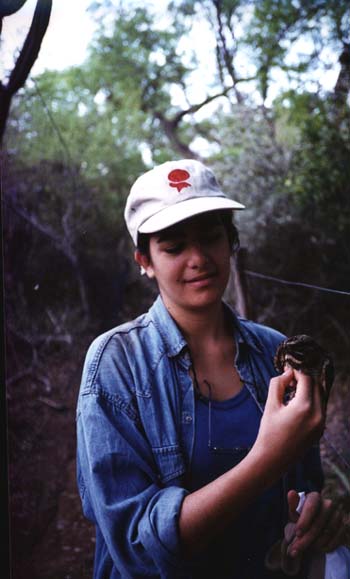
Center for Biodiversity and Conservation
American Museum of Natural History
Central Park West at 79th Street
New York, NY 10024

Center for Biodiversity and Conservation
American Museum of Natural History
Central Park West at 79th Street
New York, NY 10024
Telephone:
(212) 313-7052
Fax: (212) 769- 5292
Email: [email protected]
*Please note that I am in the process of updating this page!!!! Except for the contact info above, everything else is outdated... check again soon!*
At the net with a Caprimulgus parvulus
Welcome!
Here's what you can find on this page:
I was born in Uruguay, in the beautiful city of
Montevideo (picture), on January 23, 1973.
I lived in Brazil for 7 years during my childhood
and then returned to Uruguay, where I completed high school and undergraduate
studies. I moved to New York City in 1996 to be closer to the man I love
and to pursue doctoral studies.
Professional Preparation
2000 Ecology and
Evolutionary Biology Master of Philosophy, Columbia
University, N.Y.
Expected graduation from E3B doctoral program: Spring 2002
2000 Certificate in Environmental Policy, Columbia University, N.Y.
1996 Licenciatura
en Ciencias Biologicas (B.Sc.)
Universidad de la República, Facultad
de Ciencias, Uruguay
Appointments
1996 - present
Graduate Fellow, Department of Ornithology
and Center for
Biodiversity & Conservation American Museum of Natural History,
and Department of Ecology, Evolution, and Environmental Biology
(E3B) and CEhttp://www.cerc.columbia.eduRC,
Columbia University
Spring 1999
Project Manager to the annual Environmental
Policy Studies Workshop held at the School of International and Public
Affairs (SIPA), Columbia University.
1995 - 1996
Research Assistant at the Laboratory
of Evolution, Facultad de Ciencias, Universidad de la República,
Uruguay.
Summer 1995
Women's Committee Undergraduate
Fellow at the National Museum of Natural History, Smithsonian Institution.
Research Interests & Activities
I am primarily interested in molecular systematics and biogeography of vertebrates. My doctoral dissertation research intends to contribute data to the historical analysis of the aridland endemic avifauna of South America, by generating hypotheses of aridland area relationships based on phylogenetic hypotheses for eight monophyletic avian groups containing aridland endemics (see summary of project below). My research to date has been targeted towards establishing phylogenetic relationships among the nine genera in the family Tinamidae (Porzecanski 1999, 2000, and Porzecanski manuscript in preparation), as well in the genus Paroaria. I am currently working on the systematics of four additional avian lineages.
I am also interested in environmental policy and
conservation biology issues, especially access to genetic resources and
natural resource management conflicts.
DISSERTATION PROJECT SUMMARY
Historical biogeography of the South American Aridlands: a Molecular Phylogenetic Study of Endemic Avian Taxa
A number of biogeographic hypotheses have been proposed to explain diversification in the wet forests of South America, but the distinctive endemic aridland biota has seldom been studied. Even though endemic bird taxa have been tabulated and areas of endemism postulated, explicit historical analysis of the aridland endemic avifauna is lacking. Whether the taxa found in each of the aridland areas of endemism diversified in response to common historical factors, or have instead had independent histories remains a central question in South American biogeography.
The research proposed is a historical biogeographic
study of the relationships among seven arid and three forest areas of endemism,
based on molecular phylogenies for eight avian clades. Mitochondrial sequences
will be used to investigate phylogenetic relationships among aridland endemics.
Historical biogeographic analyses will be employed to test the existence
of a common hierarchical pattern of area relationships, as well as
to estimate the relative importance of dispersal and vicariance in the
diversification of the target taxa. The systematic and biogeographic knowledge
generated by this study will constitute an essential framework for studies
in comparative biology within these avian lineages, and will help establish
a predictive framework for establishment of conservation priorities.
Publications & Papers Presented
Porzecanski, A. L. 2001. Historical biogeography of the South American aridlands: preliminary hypotheses based on phylogenies for four avian groups. Abstracts of papers presented at the 119th Meeting of the American Ornithologist's Union, University of Washington, Seattle, WA: 46-47.
Porzecanski, A. L. & J. Cracraft, 2001. Biogeographic area-relationships of the Neotropical arid areas of endemism based on raw distributions of birds. Abstracts of papers presented at the 119th Meeting of the American Ornithologist's Union, University of Washington, Seattle, WA: 96-97.
Porzecanski, A. L. 2000. Relações filogenéticas entre os gêneros da família Tinamidae com base no gene mitocondrial citocromo b. In "Ornitologia Brasileira no Século XX, incluíndo os resumos do VIII Congresso Brasileiro de Ornitologia," Universidade do Sul de Santa Catarina (UNISUL), Sociedade Brasileira de Ornitologia, pages 217-218.
Porzecanski, A. L. 2000. Systematics of the family Tinamidae and implications for the biogeography of arid regions in South America. Abstracts of papers presented at the 118th Meeting of the American Ornithologist's Union, Memorial University of Newfoundland, Canada: 74.
Porzecanski, A. L. et al. ("EPS Workshop"). 1999. "Access to Genetic Resources: An Evaluation of the Development and Implementation of Recent Regulation and Access Agreements." Published electronically by the School of International and Public Afairs at Columbia University.
Porzecanski, A. L. 1999. "Intergeneric Relationships of Tinamous (Tinamidae) Based on Mitochondrial Sequence Data." Abstracts of papers presented at the 117th Meeting of the AOU, Cornell University, Ithaca, New York: 80.
Porzecanski, A. L. 1999. "Land Management
and Agricultural Production in the Bañados Del Este Biosphere Reserve
(Uruguay)" Abstracts from the 13th Annual Meeting of the Society
for Conservation Biology, University of Maryland, College Park, MD: 98.
Pre-1950
biogeographical bibliography
Phylogeny
Programs
Thesaurus
of geographic names
Maps
of South America during the Pleistocene
How to
apply for graduate school in the US (en español)
Incredibly
beautiful pictures of Madagascar's biota